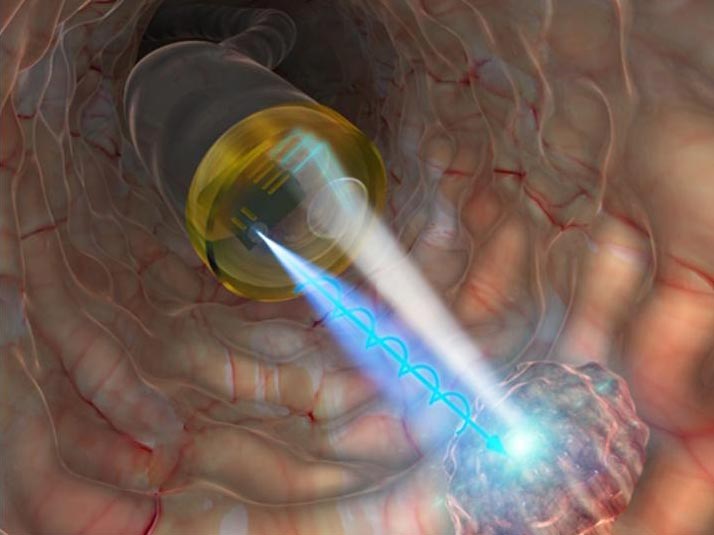Towards the in vivo detection of cancer progression using circularly polarized LEDs

Schematic illustration of the proposed technique using spin-LEDs on the tip of an endoscope. This image was selected as an inside cover of Journal of Biophotonics.
Credit: Journal of Biophotonics
Researchers at Tokyo Institute of Technology (Tokyo Tech) have experimentally demonstrated a novel cancer diagnosis technique based on the scattering of circularly polarized light. Computational studies revealed that this technique can detect the progression of precancerous lesions and early cancer. This method can be implemented using an endoscope equipped with spin-LEDs–devices that emit circularly polarized light.
Most cancers of the digestive system emerge in the surface layer first and then progress into deeper layers. While surface layer carcinomas can be readily treated using an endoscope, carcinomas that have advanced onto deeper layers need surgical intervention to prevent them from metastasizing to lymph nodes or other organs. Thus, accurate measurements of the depth of cancer progression without damaging tissues are important to obtain useful information for making treatment-related decisions.
Current endoscopic diagnosis techniques like narrow-band imaging can only confirm the presence of cancer and distinguish between tumorous and non-tumorous tissue. There are very few direct measurement techniques that can provide a quantitative diagnosis of the depth and area of a carcinoma.
To tackle the abovementioned issue, a multinational research team led by Dr. Nozomi Nishizawa of Tokyo Tech recently conducted a study to demonstrate a novel cancer diagnosis technique using circularly polarized light. Their findings have been published in the Journal of Biophotonics, and a scientific illustration of the study was selected as an inside cover in the journal (Figure 1).
Their approach relies on how circularly polarized light interacts with healthy and unhealthy cells. “The depolarization of circularly polarized light scattered from biological tissues depends on structural changes in cell nuclei, which can provide valuable information for detecting cancer concealed in healthy tissues,” explains Dr. Nishizawa. The team experimentally demonstrated this fact by shining near-infrared circularly polarized light on sliced tissue samples of murine liver containing metastatic lesions derived from intrasplenically injected human pancreatic cancer cells. They observed clear differences in the degree of circular polarization of the light scattered from the samples depending on the state of the biotissue, showing that cancer identification is possible with this technique (Figure 2).
Moreover, through computational studies with numerical simulations incorporating the scattering phenomena of circularly polarized light, the team also demonstrated that the depth profile of biotissues can be obtained by manipulating the detection angle. In short, the sampling depth in the target biotissue becomes deeper as the emission angle of the scattered light becomes close to perpendicular. Therefore, this dependence on the emission angle provides information on the depth profile of tissues or, in other words, the cancer’s progression toward the deeper layers.
However, one technical challenge had to be addressed to make this diagnosis method feasible: circularly polarized light cannot travel through optical fiber without losing its polarization. Therefore, the use of circularly polarized light in vivo requires a compact source of circularly polarized light. One promising candidate for such a source is spin-LEDs–devices developed by the researchers. In 2017, they succeeded in creating spin-LEDs capable of emitting almost pure circularly polarized light at room temperature. “By combining our novel technique based on circularly polarized light scattering and spin-LED devices, we will be able to determine the progression of precancerous lesions in vivo,” remarks Dr. Nishizawa. To this end, in their latest study, the team designed the structure of an endoscope probe containing circularly-polarized LEDs, which can detect scattered light with various emission angles simultaneously (Figure 3).
The researchers are hopeful that the proposed technique will find application in the diagnosis of ulcerative colitis and alcoholic cirrhosis in future. Moreover, it could also be applied for the observation of engraftments in regenerative medicine and transplant surgery.
###
About Tokyo Institute of Technology
Tokyo Tech stands at the forefront of research and higher education as the leading university for science and technology in Japan. Tokyo Tech researchers excel in fields ranging from materials science to biology, computer science, and physics. Founded in 1881, Tokyo Tech hosts over 10,000 undergraduate and graduate students per year, who develop into scientific leaders and some of the most sought-after engineers in industry. Embodying the Japanese philosophy of “monotsukuri,” meaning “technical ingenuity and innovation,” the Tokyo Tech community strives to contribute to society through high-impact research.
All latest news from the category: Life Sciences and Chemistry
Articles and reports from the Life Sciences and chemistry area deal with applied and basic research into modern biology, chemistry and human medicine.
Valuable information can be found on a range of life sciences fields including bacteriology, biochemistry, bionics, bioinformatics, biophysics, biotechnology, genetics, geobotany, human biology, marine biology, microbiology, molecular biology, cellular biology, zoology, bioinorganic chemistry, microchemistry and environmental chemistry.
Newest articles

Largest magnetic anisotropy of a molecule measured at BESSY II
At the Berlin synchrotron radiation source BESSY II, the largest magnetic anisotropy of a single molecule ever measured experimentally has been determined. The larger this anisotropy is, the better a…

Breaking boundaries: Researchers isolate quantum coherence in classical light systems
LSU quantum researchers uncover hidden quantum behaviors within classical light, which could make quantum technologies robust. Understanding the boundary between classical and quantum physics has long been a central question…

MRI-first strategy for prostate cancer detection proves to be safe
Active monitoring is a sufficiently safe option when prostate MRI findings are negative. There are several strategies for the early detection of prostate cancer. The first step is often a…



